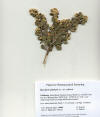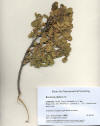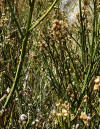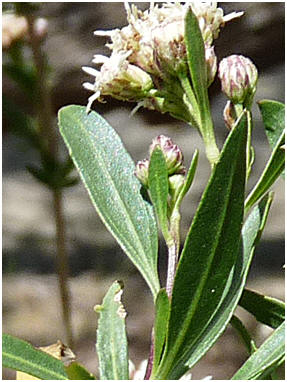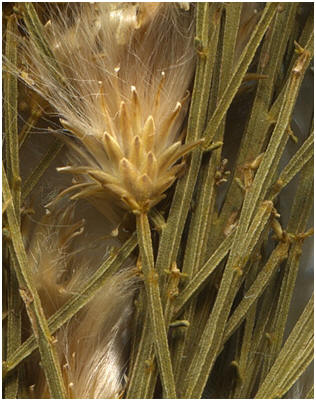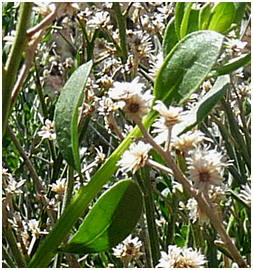|
Baccharis megapotamica |
Baccharis pilularis |
|
Baccharis pilularis |
Baccharis salicifolia |
|
Baccharis sarothroides
|
Baccharis salicifolia |
Baccharis sergiloides |
Baccharis sergiloides
|
|
Trees and Shrubs of Kern County (Sep 2012) Baccharis Perennials, subshrubs, shrubs, or trees; leaves simple, alternate, often resinous (gland dotted) without hairs and deciduous by flowering, 1–3 nerved; flower heads unisexual on separate plants; flowers white to yellowish or greenish; involucres 3–9 mm diam. with 20–40 bracts in 2–5 imbricate graduated series; involucral bracts papery to nearly herbaceous, often torn or ciliate along margins; male flowers 10–50; females 20–150 per head. Fruit: cypsela with capillary bristles, longer in fertile heads, pericarpia compressed to prismatic, 4–10 ribbed or nerved. ±400 spp. in the New World Mediterranean and tropical climates; 11 in the U.S., 9 in California, 5 in Kern Co. 6 spp. used medicinally by native American Indians. 71–80 spp. represented by 157 samples were screened by the NCI for antitumor activity before 1976, extracts from 6 species were active (USDA Memorandum, Spjut, Jun 21, 1976). Trichothecenes, produced also by endophytic fungi, isolated from plant samples of B. megapotamica, a Brazilian species, were evaluated clinically for treating cancer in humans during the 1970’s. Similar toxic compounds have been found in other Brazilian species, particularly in female plants.
1. Plants with numerous erect green leafless angled stems ..............................................2 1. Plants leafy............................................................................................................... 3
2. Flower heads often
solitary at ends of long branchlets; female heads
2. Flower heads often
clustered in 3’s at ends of branchlets, and/or solitary
3. Leaves relatively
short, widest above mid region, often with few
3. Leaves long tapered
to apex, entire or finely serrate distally or
4. Perennial spreading
by underground horizontal stem-root complexes; 4. Shrub with one to several stems; pericarpium glabrous............. . Baccharis salicifolia
Baccharis glutinosa Persoon 1807 (includes B. douglasii DeCandolle). Sticky baccharis. Rhizomatous, simple-stemmed, glutinous perennial to 2 m; stems ascending to erect, gland-dotted; leaves 3-veined from base, <10× longer than wide, sword-shaped, to 13 cm, short-petioled, entire to finely serrate, gland-dotted; plants with separate male and female flower heads in rounded to flat-topped arrangements; female flowers 80–150 per head, male flowers 26–40 per head; involucre hemispheric; bracts narrow, 2–4 mm, acuminate, resinous. Fruit: cypsela with capillary bristles 2.5–4 (-7) mm; pericarpium 5-ribbed, 0.6–1.5 mm, glandular and hairy at tip. Fresh and salt water marshes along the coast and inland stream-banks below 4,000 ft, Oregon to Baja California. Type from Chile, Concepcion & Puchacay Provinces. Kern Co.: Dense colonies “in mostly subalkaline soil...lower Santos Canyon in the Temblor Range (below the old Santos cabin...) and at the potrero in upper San Emigdio Canyon” (Twisselmann). Also, flood-wash zone, alongside southwest bank of Corn Canal, adjacent to intersection of Hwy 58 and Lokern, and along the Kern River, Bakersfield, 75–1,117 m (CCH).
Dried powdered stem applied as a disinfectant to wounds;
infusion of plant taken for kidney ailments ; the Diegueño and the
Costanoan (Moerman). Baccharis salicifolia (Molina salicifolia Ruiz & Pavon 1798) Persoon 1807 ssp. salicifolia. [Baccharis glutinosa Persoon misapplied]. Mule fat seep willow, mulefat thickets. Willow-like shrub, stems one to several, with occasional spreading or ascending reddish glutinous branches, to 4 m; leaves alternate and spirally disposed as opposed to being in one plane, nearly sessile, sometimes with additional axillary leaves, 1–3 parallel veined, especially undersurface, the midrib more prominent, entire to serrate, especially in the upper half, elliptical to wider below mid region, ~10× longer than wide, to 15 cm, tapering gradually at both ends, resinous gland dotted. Flowering spring to fall; male and female flowers on separate plants; flower heads numerous and crowded terminally, the female flowers 50–150 in a head, the male with <50 flowers–as few as 10; involucre hemispheric, phyllaries 2–4 mm, awl-shaped to lanceolate, irregularly toothed, green or reddish tinged, obtuse to long-tapered. Fruit: cypsela with white capillary bristles 3–6 mm; pericarpium 5-ribbed, 0.8–1.3 mm, glabrous. Riparian woodlands, especially disturbed sites, often in thickets, to 8,000 ft, western U.S., Texas, Mexico and South America. Mulefat thickets recognized in MCV2 when >50% relative cover in shrub canopy. Type from Huánuco, Peru. Summer–fall forms have terminal flowers with mostly toothed leaves formerly separated from winter–spring flowering forms that develop entire leaves and lateral flower heads. Kern Co.: Widespread, 350–1,363 m (CCH). Leaves used as a wash to prevent baldness and to increase hair growth by the Cahuilla and the Costanoan Indians, also applied to bruises, wounds or insect stings by the Diegueño, and as an eye wash by the Coahuilla (Moerman).
Baccharis salicina
Torrey & A. Gray 1842
[Includes B. emoryi A. Gray ]. Willow baccharis.
Glabrous, sticky shrub with erect much-branched ascending stems, 1–3 m;
leaves 3-veined from base, with a short petiole, wedge-shaped near base,
widening to above mid region, 2–7.0 cm and 0.5–1 (-2) cm wide, sparsely
1–3 toothed, the teeth shallow and blunt. Flowering Aug–Dec; flower
heads 3–5 in panicle-like clusters; involucre cylindric to bell-shaped;
phyllaries 2–6 mm, lanceolate, glabrous, gland-dotted, sticky, tips
acute. female flowers 25–30, male 20–25. Fruit: cypsela with white
capillary bristles, 8–12 mm, pericarpium 8–10 ribbed, 1.2–2 mm. Stream
banks, alkaline marshes below 5,000 ft; southern California to Mexico,
Texas, Kansas. Type from the banks of the Arkansas River. Kern Co.:
“Occasional around Bakersfield, mostly along Kern River (Twisselmann);”
also Sand Canyon above Poso Creek, and Red Rock Canyon State Park,
northwest edge of El Paso Mountains, Tarweed Creek, ~75 meters west of
bridge over creek on Highway 14, 122–725 m (CCH). Baccharis sarothroides A. Gray 1882. Broom baccharis. Shrub or tree-like with crooked trunks and many erect broom-like branches, to 5 m; trunks with a fibrous furrowed bark, young stems dark to olive green, sharply 4-angled, glabrous; leaves mostly scale-like on young stems, subterete, not with petiole, to 3 mm× 1–2 mm, entire, longer (to 2,5 cm) and linear scattered leaves seasonally present; flowering Aug–Nov or any month following rain; flower heads not stalked but on long branchlets near ends of main branches, most often solitary, cylindric; phyllaries sword-shaped, round at base, triangular above, 1–5 mm, tips rounded to acute; female flowers 19–31; male 18–35. Fruit: cypsela with white to tan capillary bristles 7–12 mm, exceeding involucre by twice its length, pericarpium 8–10-ribbed, 2–2.6 mm, glabrous. Sagebrush-grassland steppe, gravel or sand washes, below 6,500 ft; southwestern New Mexico adjacent northern Mexico to southern California and Baja California to Comondú. Type from San Diego Co. Kern Co.: Southern Sierra Nevada/Western Mojave Desert region, Short Canyon, west of Ridgecrest and Hwy 14 in the foothills of the Sierra Nevada, south of Owens Peak (Charlton, 25 May 1992; CCH). I have not seen the specimen. Lepidospartum squamatum, which is common in Short Canyon, which could be easily misidentified for this species, is distinguished by the dark green, 4-angled stems with the scale-leaves entirely appressed to the stems, ending in a short triangular pointed segment.
Infusion of plants taken by the Diegueño for treating coughs
and stomachaches (Moerman). Samples collected by Spjut in Nov 1978 from
California and earlier by a pharmaceutical company showed activity the
NCI antitumor KB assay; flavones centaureidin, and 3,5,7,
trihydorxy-3,4 dimethoxyflavone were isolated by Kupchan (Hartwell
1976). Baccharis sergiloides A. Gray 1859. Broom baccharis. Shrub with many erect leafless branches to 2 m; stems yellowish green, angled and ribbed, glabrous; leaves (when present) ± broad elliptical to wider above mid region, 1-veined, without petiole, to 3.5 cm × 0.5–1.5 cm, entire to irregularly 1–4 toothed; flowers Aug–Sep, or any month following rain; flower heads on short branches in clusters near ends of main branches, most often in 3’s; involucre funnel to bell-shaped; phyllaries sword-shaped, 1–5 mm, glabrous, tips rounded to acute; female flowers 15–30; male 24–33. Fruit: cypsela with white capillary bristles 1.7–3.1 mm, scarcely exceeding involucre, pericarpium 10-ribbed, 1–2 mm, glabrous. Gravelly or sandy streambeds, dry washes, grassland below 6,000 ft. Southern California to northern Mexico, Arizona, Utah. Broom baccharis thickets recognized in MCV2 when >3% absolute cover in the shrub canopy and >50% relative cover in the overstory where also dominant. Type from Colorado Desert, AZ or CA. Kern Co. “Occasional at springs in the desert ranges and in the desert facing canyons of the Sierra Nevada south to upper Jawbone Canyon (Twisselmann), 948–1,189 m (CCH). References on Plant Procurement and Pharmacological Activity in Baccharis USDA ARS Memorandum on species of Baccharis Screened for Antitumor Activity, R. Spjut to R Perdue, 21 June 1976. USDA ARS Plant Procurement Data for NCI Screening of Baccharis sarothroides. Baccharis sarothroides Kupchan isolated flavinoids, centauredin and 3',5,7, trihodroxy-3,4', dimethoxyflavone, based on activity in KB (Hartwell 1976). Bergmann F., B. Yagen and B. B. Jarvis. 1992. The toxicity of macrocyclic trichothecenes administered directly into the rat brain. Toxicon: 30(10):1291–1294. “The tested macrocyclic trichothecenes are produced by Myrothecium fungi and by the plant Baccharis megapotamica. The toxicity of five macrocyclic trichothecenes has been measured by intracerebral and subcutaneous injection into rats. It is assumed that the toxic effects are based on inhibition of protein synthesis. Intoxication of rats by these compounds finds expression in slowly progressing respiratory depression and paralysis of skeletal muscles. The macrocyclics are derived from verrucarol, which lacks ring D and exhibits only low toxicity. The high toxicity of the macrocyclics, established by intracerebral and subcutaneous applications, may thus be attributed to the presence of the large ring. ” Fullas F., R. A. Hussain, H. B. Chai, J. M. Pezzuto, D. D. Soejarto and A. D. Kinghorn. 1994. Cytotoxic constituents of Baccharis gaudichaudiana. J. Nat. Prod. 57(6): 801–807. “Three new labdane diterpenes, gaudichaudols A-C [1-3], a new clerodane diterpenoid, gaudichaudone [4], and the known clerodane, articulin acetate [5] have been isolated from the aerial parts of Baccharis gaudichaudiana, together with the known compounds, apigenin, hispidulin, spathulenol, and ursolic acid. Through the application of 1D- and 2D nmr spectroscopy, the structures of the new diterpenoids [1-4] were, in turn; elucidated as 15,16,18,19-tetrahydroxylabd-5-ene, 15-O-acetyl-16,18,19-trihydroxylabd-5-ene, 16-O-p-trans-coumaroyl-15,18,19-trihydroxylabd-5-ene, and 2 beta-hydroxy-15,16-epoxycleroda-1(10),15,16-trien-18,19-olide++ +. The isolated compounds were evaluated in P-388 lymphocytic leukemia cells as well as a battery of human cancer cell lines. Among the diterpenoids, gaudichaudol C [3], gaudichaudone [4], and articulin acetate [5] exhibited significant cytotoxic activity against certain cancer cells.” Gene R. M., C. Cartana, T. Adzet, E. Marin, T. Parella and S. Canigueral. 1996. Anti-inflammatory and analgesic activity of Baccharis trimera: identification of its active constituents. Planta Med. 62(3): 232–235. “The butanolic fraction (BT-II) derived from the aqueous crude extract was prepared from aerial parts of Baccharis trimera and assessed in anti-inflammatory, analgesia, and ulcerogenesis models. Intraperitoneal pretreatment with lyophilized BT-II, at doses ranging from 40 to 100 mg/kg, markedly inhibited carrageenan- and dextran-induced inflammation (70.4-90.8% and 25.7-71.3%, respectively) and weakly decreased C16-paf- and arachidonic acid-induced swelling (24.9-36.7% and 0-30.6%, respectively). No effect was observed, at the same doses, on zymosan-induced edema. The intraperitoneal examination indicates that the anti-phlogistic action of BT-II was not due to an irritating effect at the injection site. Besides, BT-II reduced abdominal constrictions in mice following injection of acetic acid: at 50 mg/kg, it gave 67.4% inhibition and, at 100 mg/kg, 95.1%. The ulcerogenic assay showed that the incidence of ulcers after BT-II i.p. treatment was 2/6 at 50 mg/kg and 6/6 at 100 mg/kg. Ulcerogenic indices were 1.3 +/- 0.5 and 2.7 +/- 0.8, respectively. These results indicate that B. trimera shows strong anti-inflammatory and analgesic properties which seem to be due, at least partly, to the inhibition of prostaglandin biosynthesis. The chromatographic separation of BT-II monitored by bio-assay (carrageenan-induced edema test in mice) was carried out. The active constituents were found to be mainly saponins in which echinocystic acid (or its enantiomer) is the major aglycone, and also rutin.” Herz W., A. M. Pilotti, A. C. Soderholm, I. K. Shuhama and W. Vichnewski. 1977. New ent-clerodane-type diterpenoids from Baccharis trimera. J. Org. Chem. 42(24): 3913–3917 Jarvis B. B., S. Wang, C. Cox, M. M. Rao, V. Philip, M. S. Varaschin and C. S. Barros. 1996. Brazilian Baccharis toxins: livestock poisoning and the isolation of macrocyclic trichothecene glucosides. Nat. Toxins 4(2): 58–71. “Samples of the toxic Brazilian plant, Baccharis coridifolia, which is responsible for numerous cases of livestock poisoning in southern Brazil and Argentina, were collected during the growing season, and the toxicities in calves of the plant materials were correlated with the levels of macrocyclic trichothecenes present. Female plants in flower were considerably more toxic than male plants or plants not in flower. Plants not in flower were of intermediate toxicity. The female plants in flower typically contained 5-10 times the levels of toxins as were found in the male plants. In addition, six new glucosides of the macrocyclic trichothecenes were isolated and characterized. The most prominent glucosides, those of roridins A and E, were found in high levels in the female plants.” Jarvis B. B., J. O. Midiwo, G. A. Bean, M. B. Aboul-Nasr and C. S. Barros. 1988. The mystery of trichothecene antibiotics in Baccharis species. J. Nat. Prod. 51(4): 736–744. “The Brazilian higher plant Baccharis coridifolia has been shown to synthesize de novo a series of highly toxic macrocyclic trichothecene antibiotics heretofore found to be produced only by fungi. These compounds are produced only by female plants that have undergone pollination. Neither the male nor female plant is sensitive to the toxic effects of trichothecenes, whereas North American Baccharis species are. The macrocyclic trichothecenes found in B. coridifolia are the same as those produced by Myrothecium fungi, and it is suggested that the plant has acquired the toxin-producing genes from this fungus. Kupchan S. M., D. R. Streelman, B. B. Jarvis, R. G. Dailey Jr and A. T. Sneden. 1977. Isolation of potent new antileukemic trichothecenes from Baccharis megapotamica. J. Org. Chem. 42(26): 4221–4225. Mirocha C.J., H. K. Abbas, T. Kommedahl and B. B. Jarvis. 1989. Mycotoxin production by Fusarium oxysporum and Fusarium sporotrichioides isolated from Baccharis spp. from Brazil. Appl. Environ. Microbiol. 55(1): 254–255. “Fusarium oxysporum isolated from roots of and soil around Baccharis species from Brazil produced the trichothecenes T-2 toxin, HT-2 toxin, diacetoxyscirpenol, and 3'-OH T-2 (TC-1), whereas Fusarium sporotrichioides from the same source produced T-2 toxin, HT-2 toxin, acetyl T-2, neosolaniol, TC-1, 3'-OH HT-2 (TC-3), iso-T-2, T-2 triol, T-2 tetraol, and the nontrichothecenes moniliformin and fusarin C. Several unknown toxins were found but not identified. Not found were macrocyclic trichothecenes, zearalenone, wortmannin, and fusarochromanone (TDP-1).” Mirocha C.J., H. K. Abbas, L. Treeful and G. Bean. 1988. T-2 toxin and diacetoxyscirpenol metabolism by Baccharis spp. Appl. Environ. Microbiol. 54(9): 2277–2280. “Hybrids resulting from crosses between Baccharis sarothroides and B. pilularis (FS1), B. sarothroides (FS2) and B. megapotamica (FS3) were tested for their tolerance to trichothecenes as well as their ability to metabolize the toxins. B. sarothroides (desert broom) was placed in an aqueous solution containing 500 ppm of T-2 toxin and showed visible signs of toxicity on the twigs at 21 h after exposure but not at 6 h, indicating some resistance. Samples of the twigs harvested 6 and 21 h after treatment contained, respectively, T-2 (0.03 and 2.2 micrograms/g), HT-2 (0.09 and 7.6 micrograms/g), and T-2-tetraol (2.1 and 2.6 micrograms/g). The hybrid FS1 showed no signs of toxicity 6 h after treatment, and its twigs contained T-2 (0.8 micrograms/g), HT-2 (10.2 micrograms/g), and T-2-tetraol (10.8 micrograms/g). The leaves at 6 h contained 0.5 micrograms of T-2, 1.7 micrograms of HT-2, 0.01 microgram of 3'-hydroxy-HT-2, and 41 micrograms of T-2-tetraol per g. At 21 h, toxic signs were apparent and the twigs contained T-2 (39 micrograms/g), HT-2 (62 micrograms/g), 3'-hydroxy-HT-2 (0.8 microgram/g), and T-2-tetraol (22 micrograms/g)....” Rahalison L, M. Benathan, M. Monod, E. Frenk, M. P. Gupta, P. N. Solis, N. Fuzzati and K. Hostettmann. 1995. Antifungal principles of Baccharis pedunculata. Planta Med. 61(4): 360–362. “Four compounds including a flavone, an acetylenic lactone, a prenylated coumarin, and a 3-methyl ether flavone were isolated from the dichloromethane leaf extract of Baccharis pedunculata (Mill.) Cabr. (Asteraceae). The latter three compounds were identified to be responsible for the antifungal activity against some human pathogenic and phytopathogenic fungi. The most active compound, lachnophyllum lactone, an acetylenic lactone, showed a very high toxicity (LD50 2 micrograms/ml) against human keratinocytes.” |
|


